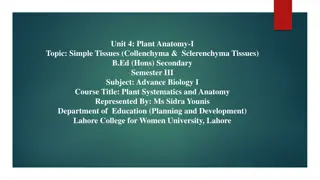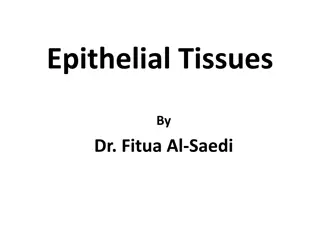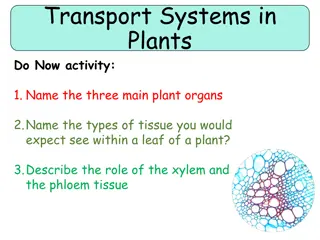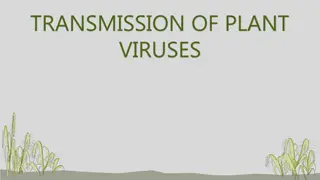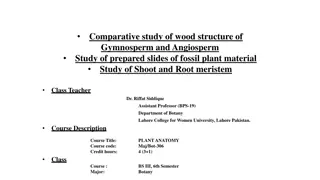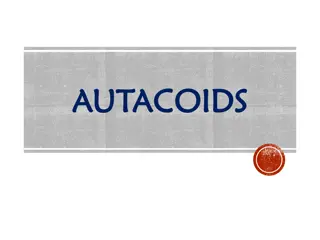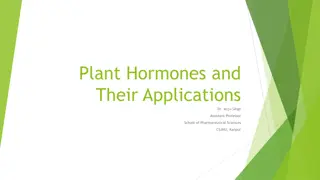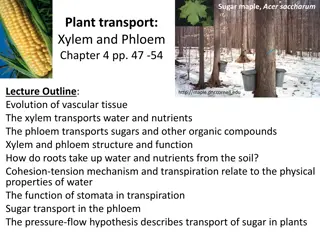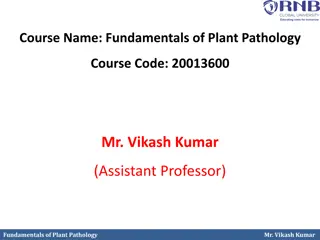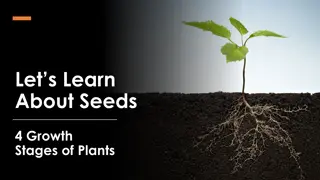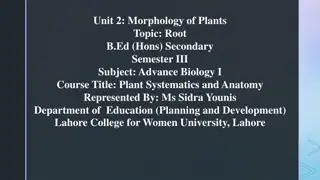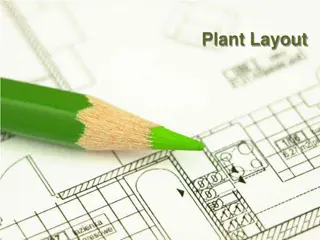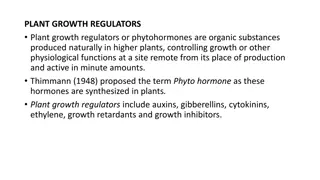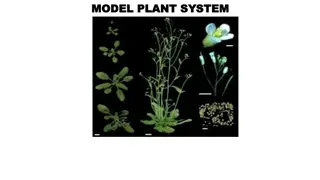Understanding Plant Permanent Tissues: Parenchyma, Collenchyma, Sclerenchyma
Plant permanent tissues, including parenchyma, collenchyma, and sclerenchyma, play crucial roles in the structure and support of plants. Parenchyma is a versatile tissue that aids in storage and rigidity, while collenchyma provides mechanical support and elasticity in growing plant parts. Sclerenchyma, with its thick and lignified cell walls, offers strong structural support. Explore the characteristics and functions of these different types of permanent tissues in plants.
Download Presentation

Please find below an Image/Link to download the presentation.
The content on the website is provided AS IS for your information and personal use only. It may not be sold, licensed, or shared on other websites without obtaining consent from the author. Download presentation by click this link. If you encounter any issues during the download, it is possible that the publisher has removed the file from their server.
E N D
Presentation Transcript
Permanent Tissue Dr Habibur Rahman Associate Professor J. N. College, Boko
Permanent Tissues The Permanent tissues develop from apical meristem. They lose the power of cell division either permanently or temporarily. They are classified into two types: 1. Simple permanent tissues. 2. Complex permanent tissues. Simple Permanent Tissues: Simple tissues are composed of one type of cells only. The cells are structurally and functionally similar. It is of three types. 1. Parenchyma 2. Collenchyma 3. Sclerenchyma
1. Parenchyma (Gk: Para-beside; enehein- to pour) Parenchyma is generally present in all organs of the plant. It forms the ground tissue in a plant. Parenchyma is a living tissue and made up of thin walled cells. The cell wall is made up of cellulose. Parenchyma cells may be oval, polyhedral, cylindrical, irregular, elongated or armed. Parenchyma tissue normally has prominent intercellular spaces. Parenchyma may store various types of materials like, water, air, ergastic substances. It is usually colourless. The turgid parenchyma cells help in giving rigidity to the plant body. Partial conduction of water is also parenchymatous cells. maintained through
Occasionally, Parenchyma cells which store resin, tannins, crystals of calcium carbonate, calcium oxalate are called idioblasts. Parenchyma is of different types and some of them are discussed as follows.
Collenchyma (Gk. Colla-glue; enchyma an infusion) Collenchyma is a simple, living mechanical tissue. Collenchyma generally occurs in hypodermis of dicot stem. It is absent in the roots and also occurs in petioles and pedicels. The cells are elongated and appear polygonal in cross section. The cell wall is unevenly thickened. It contains more of hemicellulose and pectin besides cellulose. It provides mechanical support and elasticity to the growing parts of the plant. Collenchyma consists of narrow cells. It has only a few small chloroplast or none. Tannin maybe present in collenchyma. Based on pattern of pectinisation of the cell wall, there are three types of collenchyma.
Sclerenchyma (Gk. Sclerous- hard: enchyma-an infusion) or short, narrow thick walled and lignified secondary walls. The cell walls of these cells are uniformly and strongly thickened. The sclerenchymatous cells are of two types: 1. Sclereids 2. Fibres The sclerenchyma is dead cell and lacks protoplasm. The cells are long
1. Sclereids (Stone Cells): Sclereids are dead cells, usually these are isodiametric but some are elongated too. The cell wall is very thick due to lignification. Lumen is very much reduced. The pits may simple or branched. Sclereids are mechanical in function. They give hard texture to the seed coats, endosperms etc., Sclereids are classified into the following types.
2. Fibres Fibres are dead cells and have lignified walls with narrow lumen. They have simple pits. They provide m e c h a n i c a l strength and protect them from the strong wind. It is also called supporting tissues. Fibres have a great commercial value in cottage and textile industries.Fibres are of five types Wood Fibres or Xylary Fibres These fibres are associated with the secondary xylem tissue. They are also called xylary fibres. These fibres are derived from the vascular cambium. These are of four types- a. Libriform fibres b. Fibre tracheids c. Septate fibres d. Gelatinous fibres. a. Libriform fibres: These fibres have slightly lignified secondary walls with simple pits. These fibres are long and narrow. Fibres are very much elongated sclerenchyma cells with pointed tips.
b. Fibre tracheids: These are shorter than the libriform fibres with moderate secondary thickenings in the cell walls. Pits are simple or bordered. c. Septate fibres: Fibres that have thin septa separating the lumen into distinct chambers. Eg. Teak d. Gelatinous fibres: Fibres in which lignin is less in amount and cellulose is more in this cell walls. These fibres are characteristic of tension wood which is formed in the underside of leaning stems and branches.
Complex Tissues function together as a single unit. It is of two types xylem and phloem. Xylem: The xylem is the principal water conducting tissue in a vascular plant. The term xylem was introduced by Nageli (1858) and is derived from the Gk. Xylos wood. The xylem which is derived from Procambium is called primary xylem and the xylem which is derived from vascular cambium is called secondary xylem. Early formed primary xylem elements are called protoxylem, whereas the later formed primary xylem elements are called metaxylem. Xylem Consists of Four Types of Cells 1. Tracheids 2. Vessels or Trachea 3. Xylem Parenchyma 4. Xylem Fibres A complex tissue is a tissue with several types of cells but all of them
1. Tracheids: Tracheids are dead, lignified and elongated cells with tapering ends. Its lumen is broader than that of fibres. In cross section, the tracheids are polygonal. There are different types of cell wall thickenings due to the deposition of secondary wall substances. They are -
2. Vessels or Trachea: Vessels are elongated tube like structure. They are dead cells formed from a row of vessel elements placed end to end. They are perforated at the end walls. Their lumen is wider than Tracheids. Due to the dissolution of entire cell wall, a single pore is formed at the perforation plate. It is called simple perforation plate, Example: Mangifera. If the perforation plate has many pores, it is called multiple perforation plate. Example Liriodendron. Vessels are chief water conducting elements in Angiosperms and absent in Pteridophytes and Gymnosperms. In Gnetum of Gymnosperm, vessels occur. The main function is conduction of water, minerals and also offers mechanical strength.
3. Xylem Fibre: The fibres of sclerenchyma associated with the xylem are known as xylem fibres. Xylem fibres are dead cells and have lignified walls with narrow lumen. They cannot conduct water but being stronger provide mechanical strength. They are present in both primary and secondary xylem. Xylem fibres are also called libriform fibres.
4. Xylem Parernchyma: The parenchyma cells associated with the xylem are known as xylem parenchyma. These are the only living cells in xylem tissue. The cell wall is thin and made up of cellulose. Parenchyma arranged longitudinally along the long axis is called axial parenchyma. Ray parenchyma is arranged in radial rows. Secondary xylem consists of both axial and ray parenchyma, Parenchyma stores food materials and also helps in conduction of water.
Phloem: Phloem is the food conducting complex tissues of vascular plants. The term phloem was coined by C. Nageli (1858) The Phloem which is derived from procambium is called primary phloem and the phloem which is derived from vascular cambium is called secondary phloem. Early formed primary phloem elements are called protophloem whereas the later formed primary phloem elements are called metaphloem. Protophloem is short lived. It gets crushed by the developing metaphloem.
Phloem Consists of Four Types of Cells 1. Sieve elements 2. Companion cells 3. Phloem parenchyma 4. Phloem fibres 1. Sieve Elements: Sieve elements are the conducting elements of the phloem. They are of two types, namely sieve cells and sieve tubes. Sieve Cells: These are primitive type of conducting
Pits: Pits are relatively thinner portions of the cell wall that adjacent cells can communicate or exchange fluid through it. Pitsare formed on the cell wall is due to lack of secondary wall material. Pits appear circular, oval or angular in surface view and are of two types-simple and bordered. The simple pits are the areas with only primary wall without any secondary thickening and have uniform with of the pit chamber or cavity.


